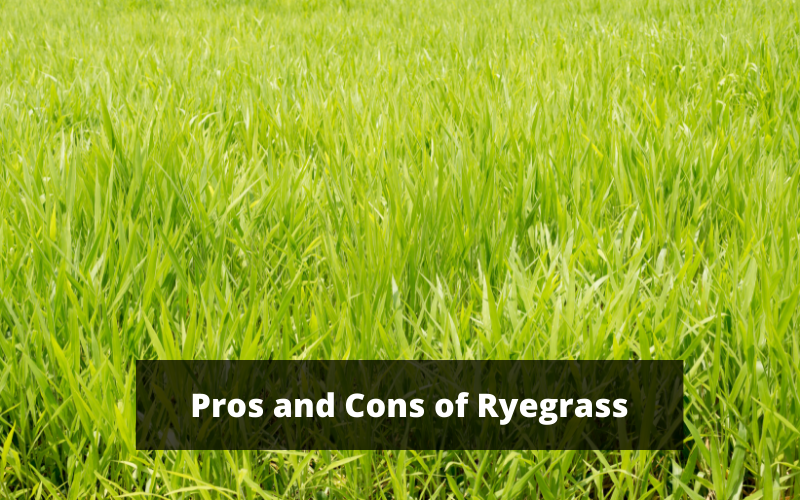By “ryegrass” we’re assuming you’re thinking of perennial ryegrass.
While annual ryegrass is sometimes used as a type of grass that can bring some color to warm-season lawns in the winter, it’s never recommended as a year-round lawn or primary grass type.
Perennial ryegrass, on the other hand, comes with many advantages (and a few disadvantages) that could make it an overlooked type of grass that may make an excellent lawn in certain situations.

Is Ryegrass Good for Lawns? – Looking at the Pros
When you’re weighing the pros and cons of ryegrass it’s easy to see why ryegrass is an attractive grass type, the pros listed below are very strong and cover nearly anything you could want from a lawn grass.
Fast Growth
Perennial ryegrass grows faster than most other types of lawn grass.
It germinates in an average of 3 days and can move past the sprout and seedling stages at blazing speed.
This means your lawn could start looking like an actual lawn in as little as 3 to 4 weeks.
High Damage Tolerance
Ryegrass of all types is highly damage resistant and, if it is damaged or if a chunk of the lawn is removed, it will likely fill in within a minimum amount of time due to the rapid growth rate of ryegrass.
Weed Inhibition
Ryegrass is often seen being allelopathic. This means that it can suppress the growth and germination of other nearby plants by essentially sending a chemical signal to them to “back off”.
This works on many unwanted types of grass and grass-type weeds.
Versatile Height Range
Do you like a short lawn or a longer lawn? Would you like your lawn to be able to conserve water during some parts of the year and disperse it more efficiently during others?
Ryegrass can be mown as low as 1.5” without feeling “scalped” or in danger. It can also be allowed to grow to 3” or even a little higher during hot weather to retain moisture.
Shade Tolerance
Most lawn grass types do perfectly well in sun but flounder in shade. Ryegrass tolerates partial shade very well with no thinning.
Prevents Erosion
Ryegrass is a deep-rooted variety of grass. This means it can make more efficient use of nutrients and water in the soil.
This can also mean that ryegrass is an excellent candidate for a lawn that is primarily fed with compost instead of fast-acting refined fertilizers.
Water Smart and Drought Tolerant
Due to the deep, complex root system mentioned above, perennial ryegrass can take from sources of water found deeper under the ground.
This helps it stay green, even when faced with drought conditions.
The Disadvantages of Ryegrass – Considering the Cons
While those are some convincing pros, ryegrass isn’t winning every category. There are a few things ryegrass does poorly with that you should know before committing.
High Feed Cost
In part to its rapid growth rate and ability to heal, ryegrass can take up and use nearly double the nitrogen of other lawn grasses. Without enough nitrogen, the ryegrass can turn a pale, undesirable green.
Ensuring that your lawn has enough nitrogen will add up to several extra maintenance hours spent each year in addition to the cost of the fertilizer.
Allelopathy
Remember that weed-inhibiting power described above? This can also mean that ryegrass will be problematic for any grasses or grass-type plants you want to grow nearby.
Whether this is a spot-planting of a groundcover or an ornamental grass, these can struggle if ryegrass is planted nearby.
Once You Have Ryegrass, You Could Have It Forever
Ryegrass is especially tough to get rid of without resorting to strong, indiscriminate chemical herbicides.
It also tends to invade flower beds, gardens, and other landscaping if a deep, solid weed or grass barrier isn’t used as a border.
2 ft. Max Height
Many types of lawn grass will get, at most, 10” to 12” high if left unattended. Ryegrass, being a prairie grass, can reach heights of 2′.
This means you won’t be able to mow it with a typical lawnmower and may have to call in a brush mower or other specialty equipment if you let it get that high.
Selective Temperature Range
All types of ryegrass are sensitive to both extreme cold and extreme heat.
Ryegrass will not tolerate a long, freezing winter without taking damage.
It will also do poorly and begin to turn yellow or brown if temperatures exceed 100F for more than a few days.
Weighing Up the Pros and Cons of Ryegrass
If none of those cons was a deal-breaker in and of itself, here’s a condensed version of both the pros and the cons to sum up.
At its best, ryegrass is fast-growing, tough, and capable of inhibiting the growth of other grass and grass-type weeds. It helps prevent erosion, does well with shade, and is relatively water-smart.
For cons, perennial ryegrass takes a lot of nitrogen to do well and stay a pleasing shade of green. If you don’t mind the cost, pay for lawn maintenance anyway, or have access to free compost this can still be a great fit.
Of all the cons, the most important to consider is the very particular temperature range. Due to this one quality, perennial ryegrass will only be worth it if you live within USDA zone 5a to 6a.
You could step up or down to 4b or 6b, if you feel like you may live in a micro-climate or one of the pros could make it worth babying your lawn through the winter but this is, often, the reason someone will skip ryegrass and choose another lawn type.


Leave a Reply